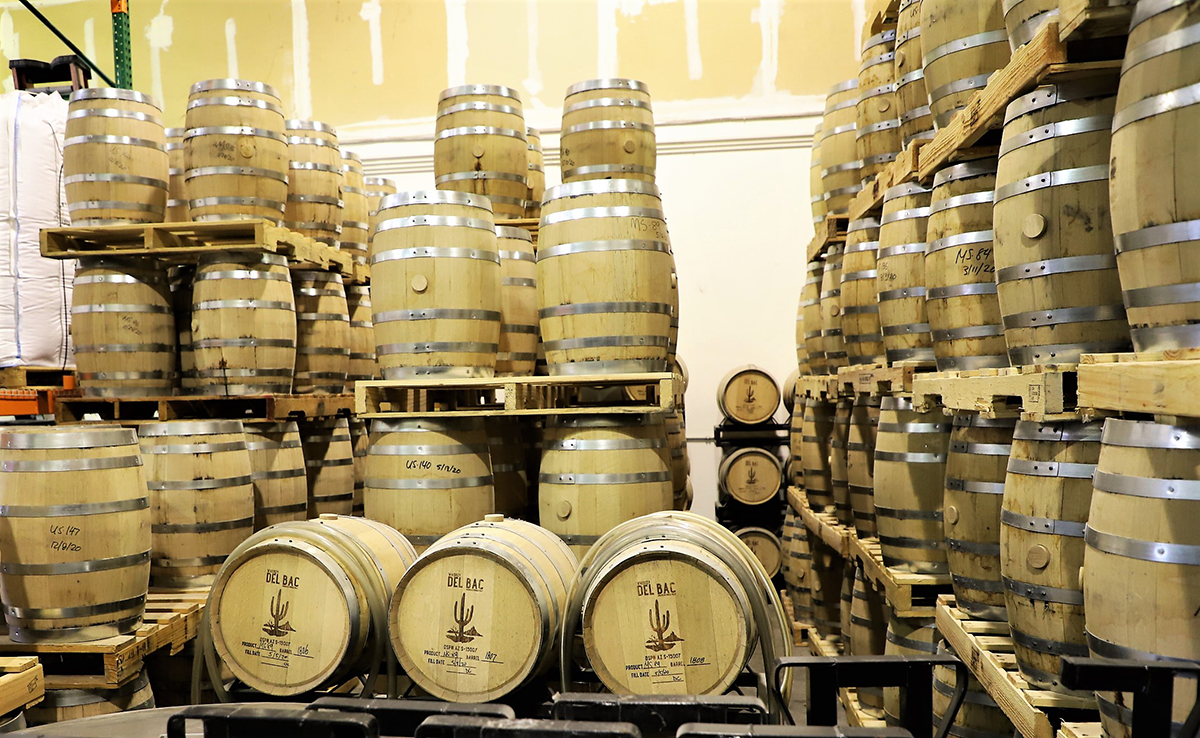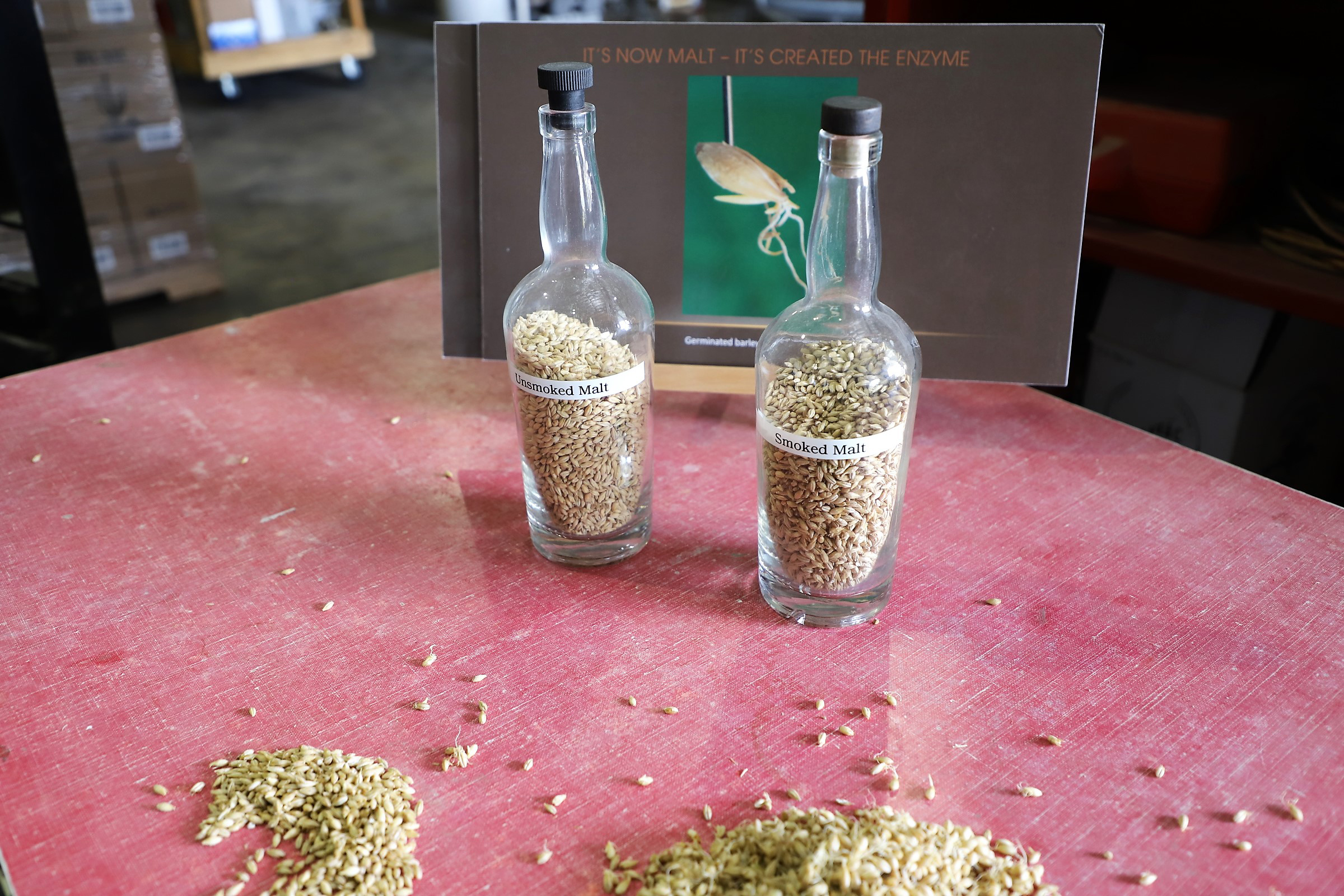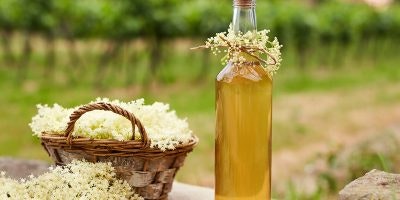When you step inside the home of Whiskey Del Bac in Tucson, Arizona, your nose is instantly greeted by the wafting aromas of mesquite smoke. It’s a distinctive touch to the distillery’s process and flavor profile. At least on malting day, that is. Indeed, the distillery is one of a small number of U.S. producers malting its own barley on-site.
The simplest description of what makes the flavor of Whiskey Del Bac bottlings different, yet recognizable, stems from its catchy “mesquited, not peated” mission statement. Consider Scotland for a moment. Peat bricks there weren’t originally used to dry out malted barley because they provided a particular flavor to the resulting Scotch whisky being produced. The material was simply an abundant fuel source. Of course in the modern era, one could choose to use any fuel or heat source for such a purpose. But why not find something local that delivered a true sense of place?
“We’ve always been single malt drinkers, and my wife [Elaine] first mentioned the idea, of well, ‘why couldn’t you use mesquite smoke instead of peat smoke?'” says Stephen Paul, co-founder of the distillery. In his life prior to the whiskey world, he ran Arroyo Design, a furniture company producing pieces made from the unique aesthetic provided by mesquite. As someone born and raised in Tucson, the fit couldn’t have been more perfect to continue moving in that same direction with whiskey. “I’ve always been in love with the Sonoran Desert, and the idea was always making a whiskey that was from this place.”
The Mesquite Smoke Process
Paul began tinkering with distillation and some unofficial experiments back in 2007 before starting the business in earnest in 2011. He began by floor malting and smoking the grain with what he refers to as a “glorified meat smoker.” But it was eventually time to switch to a more modern and convenient approach. Now Whiskey del Bac deploys a two-in-one germination and kilning tank. “This is a prototype system the fabricator designed for us,” he explains.
Inside the tank is a large arm with four augers on it. Several times per day during the germination process, the machine performs a few rotations, churning over the three-foot deep grain bed inside — about 5,000 lbs worth. Sure beats dragging a rake over barley spread out over an entire warehouse’s floor, doesn’t it? When it’s time for kilning, a mesquite log fire is built and maintained within a furnace out behind the distillery. Temperatures reach as high as 800-900 degrees for parts of the process, and the smoke is piped straight into the tank at the appropriate times.
Managing the fire and its temperature to ensure the appropriate quality and quantity of smoke is fed to the barley is intensive. But, the end goal is not a scientifically measured or pinpoint-precise level of smoke. Instead, the team follows the tried and true process they’ve honed over the years. Case in point, Paul doesn’t know or care much about his whiskey’s PPM level. “We don’t even measure it,” he says. “I’ve never really been concerned about it because we only make one thing as far as malt.” Still, he’s now having some sent out for testing and is interested to see the results.

Barrels at Whiskey Del Bac / Photo Credit: Jake Emen
The Whiskeys
Whiskey Del Bac produces a core line of three whiskeys: Dorado, the mesquite-smoked single malt; Classic, which isn’t smoked at all; and Old Pueblo. The latter is an un-aged offering of the mesquite-smoked whiskey which might capably sub in for mezcal in a cocktail. In addition there’s also a series of Distiller’s Cut releases, generally a limited, quarterly release offered at cask strength. Moreover, they’re finished in casks such as PX sherry, calvados, cognac and Madeira, among others.
The Classic offers a fruity and caramel character on the nose, with butterscotch and a rich palate. “I call this the ‘control,'” Paul says. The Dorado offers an underlying current of mesquite, which hits particularly on the back palate. But it’s altogether quite balanced, with the caramel, fruits, and richness of the Classic coming through.
While Dorado is the top seller, the distillery actually produces more of the Classic. The key to unlocking that riddle is the specific production process it uses. A decent chunk of the un-smoked Classic, about 25%, is actually blended into Dorado, taming the beast in a way. “Early on, it was a lot more mesquited, a lot more smoke heavy,” Paul says.
Having first tasted the Whiskey Del Bac range six years ago, I recalled a big ol’ mesquite punch to the face. This aromatic profile was certainly intriguing with its distinctive character but was nevertheless a work in progress. The lineup today is far more subtle and refined. That’s a testament to the distillery’s ability to continue working on its craft, improving the process, and well, maturing. Sometimes people forget that a craft distillery and its products *should* be getting better as time goes on, too; otherwise what in the world have they been doing?
Aging Whiskey in the Desert
Another unique element to Whiskey Del Bac is the desert itself. “Climate plays a big role in our maturation program, as it’s pretty damn warm in the summer,” Paul says, leveling a rather stark understatement for anyone who’s familiar with Tucson in the summer. “Also we have a pretty radical diurnal shift here.” That daily temperature swing is a huge driver of maturation, with the spirit being pulled in and out of the cask. He cites a recent one day swing of 36-81 degrees as an example. And while that’s extreme, a 40-degree daily shift is fairly common.
That’s why current maturation time is about 12-14 months, in medium char, medium toast, 15-gallon barrels. Paul would love to switch to full-size 53-gallon barrels, “we’ve been forever scrambling to keep up with demand,” he says. When you can mature your whiskey in a year and don’t have built up stock because you’re moving it all, it’s hard to put a pause on things for a transition which could take years. “It’s like being addicted to them.”

Smoked and Unsmoked Malt at Whiskey Del Bac / Photo Credit: Jake Emen
The Future
Of course, one way to address that is with expansion. So it’s not surprising to hear that Whiskey Del Bac has a plan in place. It’s in the process of scaling up at its existing location, taking production from 4,200 9-liter cases to 7,500 cases. That’s a stepping stone en route to a new facility the brand is hoping to launch by 2023, which will increase production to an estimated 30,000 cases annually, while serving as a more expansive brand home and visitor’s center.
Considering that plan, and the quality of product currently being offered, it’s not unusual to be wondering if one of the large spirits conglomerates could come calling. And perhaps they have, but that’s not in the cards for now. Nor is it the motivation behind Whiskey Del Bac’s efforts. “I never had money in mind when we started this thing,” Paul says. “My main thing is, I want to continue making good whiskey and I want to maintain our ethos and working culture and sense of place.”
For Whiskey del Bac, it’s a sense of place you can literally smell in the air.
Ready to try some of Whiskey Del Bac’s offerings?
Article tie in to download:
With Distiller, you’ll always know what’s in the bottle before you spend a cent. Rate, Review, and Discover spirits. Head on over to Distiller, or download the app for iOS and Android today!
Want to enjoy Distiller ad-free plus exclusive discounts, giveaways, features and other perks? Join Distiller Pro today to support the Distiller platform and keep ads off of your screen.


